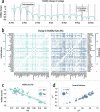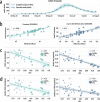Estimating the effect of social inequalities on the mitigation of COVID-19 across communities in Santiago de Chile
- PMID: 33893279
- PMCID: PMC8065143
- DOI: 10.1038/s41467-021-22601-6
Estimating the effect of social inequalities on the mitigation of COVID-19 across communities in Santiago de Chile
Abstract
We study the spatio-temporal spread of SARS-CoV-2 in Santiago de Chile using anonymized mobile phone data from 1.4 million users, 22% of the whole population in the area, characterizing the effects of non-pharmaceutical interventions (NPIs) on the epidemic dynamics. We integrate these data into a mechanistic epidemic model calibrated on surveillance data. As of August 1, 2020, we estimate a detection rate of 102 cases per 1000 infections (90% CI: [95-112 per 1000]). We show that the introduction of a full lockdown on May 15, 2020, while causing a modest additional decrease in mobility and contacts with respect to previous NPIs, was decisive in bringing the epidemic under control, highlighting the importance of a timely governmental response to COVID-19 outbreaks. We find that the impact of NPIs on individuals' mobility correlates with the Human Development Index of comunas in the city. Indeed, more developed and wealthier areas became more isolated after government interventions and experienced a significantly lower burden of the pandemic. The heterogeneity of COVID-19 impact raises important issues in the implementation of NPIs and highlights the challenges that communities affected by systemic health and social inequalities face adapting their behaviors during an epidemic.
Conflict of interest statement
A.V. and M.C. report grants from Metabiota Inc., outside the submitted work; M.T. reports personal fees from GSK, outside the submitted work. All other authors declare no competing interests.
Figures



References
-
- Covid-19 in Chile. https://www.gob.cl/coronavirus/cifrasoficiales/ (2020).
-
- Chilean government interventions against COVID-19. https://www.gob.cl/coronavirus/plandeaccion/ (2020).
-
- Shi, Q. et al. Effective control of SARS-CoV-2 transmission in Wanzhou, China. Nat. Med.27, 86–93 (2021). - PubMed
Publication types
MeSH terms
LinkOut - more resources
Full Text Sources
Medical
Research Materials
Miscellaneous

